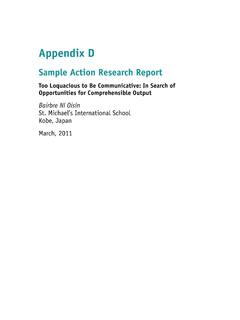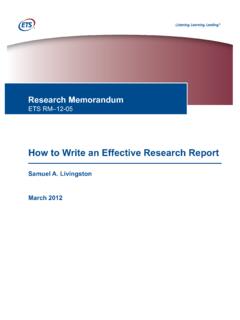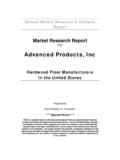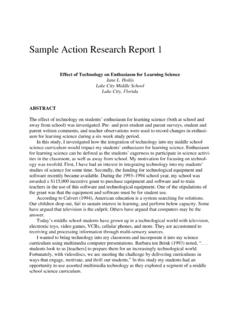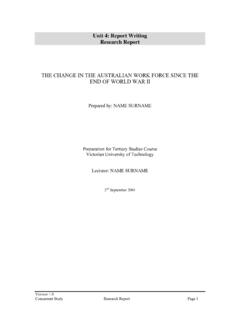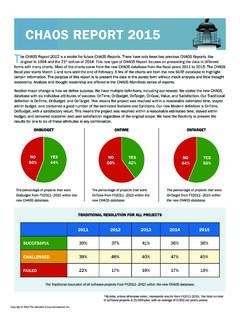Transcription of Action Research Sample 1 – Grades 2 & 3
1 Action Research samples , page 1 Action Research Sample 1 Grades 2 & 3 Participants: Name Role Site/District A Belling 2nd grade teacher T Lake Elementary S Hauge 2nd grade teacher T Lake Elementary E Leismeister 2nd grade teacher T Lake Elementary J Mattsson 3rd grade teacher T Lake Elementary K Pallante 3rd grade teacher T Lake Elementary C Waldon 3rd grade teacher T Lake Elementary D Johnstone Principal T Lake Elementary J Arennes Instructional coach T Lake Elementary Context: Where, when, with whom, and why (your purpose) will the Action Research be conducted? Please provide a one-paragraph description of the Research study s purpose, subjects/participants, methods and procedures, and desired results/ findings. This Action Research study was conducted over the course of the 2011 2012 school year in a suburban district in the Minneapolis, MN area. The study took place in all of the 2nd and 3rd grade classrooms at T Lake Elementary School in the XX school district.
2 The students in the T Lake Elementary 2nd and 3rd Grades represented the full range of learning needs (gifted/talented, special education, 504 plans, 2nd language learners, with a range of socio-economic status). All learners and all teachers participated in the study. The purpose of the study was to explore ways to increase student achievement by using formative assessment practices to increase student engagement in the learning process. Action Research Question to answer (what is it you hope to accomplish or learn as a result of this effort?): How will the use of questioning strategies, including error analysis, effect student engagement? (note: initial question was specific to reading but the designation of reading was later dropped as the strategies began to carry over into all subjects.) Action Research samples , page 2 Answering the Action Research Question with data, artifacts and evidence: Classroom Strategies/Actions What strategies will you need to employ or what tools will you need to design in order to answer your question?
3 Indicators of Success What will be your indications of success for each strategy or tool that you decide to use? Monitoring Impact What tools ( surveys, rubrics, achievement data, etc.) will you need to use to monitor your progress along the way, support your decision making and report your final conclusions? What will the data look like? 1. Employ powerful questioning strategies: HOT questions, Responding to right and wrong answers with questions, Randomizing student responses (no hand raising) 1. Increased rigor in questions and responses Q & A form to write HOT questions as a team (data: levels of questions and number of questions at high levels) Rubric with HOT criteria for random responses. (data: pick 3 random learners to observe per day / 2 days a week and record qualitative examples of high level responses. Document quantity and quality of responses) Video footage for team review/scoring (data: rubric score for HOT questions and answers 2.)
4 More learners responding everyone accountable to the learning Tracking forms to monitor student responses (data: number of students selected for answers, number of students not selected at all, number of students selected more than once) Observations (data: qualitative teacher observations, particularly for those who seem less likely to want to answer questions) 3. Increased confidence in teachers & learners Test/quiz/homework scores (data: no. students earning higher scores; no. students earning low scores, etc.) Confidence survey following a test (data: no. students showing high levels of confidence/ correlation between confidence and success) Team reflection on confidence with responding to wrong answers and calling on all learners (data: qualitative findings, teacher confidence self reported scores) Number of teaching strategies for randomizing respondents, tracking data, and responding to errors (data: list of strategies used) Action Research samples , page 3 2.
5 Engage learners in error analysis: during instruction [ My Favorite No strategy], in the Q & A [explore multiple answers], through the assessment process, and during reflection after an assessment. 1. Increased ability to recognize and auto-correct errors (T & L) List of number and types of errors per target Observations (students auto-correcting with comments or visiually) 2. Increased speed with which learners can improve learning ( learners work harder than teachers) List of instructional strategies (T & L) to fix specific errors Observations of student ability to recognize and self correct Observations of whole class and small group ability to explore and analyze errors Reduction in number and types of errors right before and during the summative assessment 3. Targeted instructional strategies List of instructional strategies (T & L) to fix specific errors Length of time for reteaching/intervention sessions before mastery is achieved 3.
6 Explore student engagement with the learners: surveys, engage-o-meter, plus/delta class reflections, self reflection forms, video taped lesson(s) for review and analysis 1. Students ACT more engaged Observations (list of engaged patterns and beliefs) Shared scoring of engagement with video (list of engaged patterns and beliefs) 2. Students REPORT higher engagement levels Scores on pre/post surveys outlining engagements levels Engage-o-meter results (data: tracking for improvement at high levels of sustained engagement Plus/delta findings (data: qualitative reports on what it looks/feels like to be engaged) 3. Teachers observe increase in engagement Engage-o-meter results (data: tracking for improvement at high levels of sustained engagement Action Research samples , page 1 Resources (what will support your efforts at the classroom level or with the Action Research process?) Video recording equipment Someone to do the recording Time to co-plan shared lessons and time to review video(s) Popsicle sticks (multiple classroom sets per teacher some will have names on and some will not) Solo cups for engage-o-meter Audience with whom to share your findings: T Lake Elementary Staff at a staff meeting in May Whole district team of Action researchers in later May))
